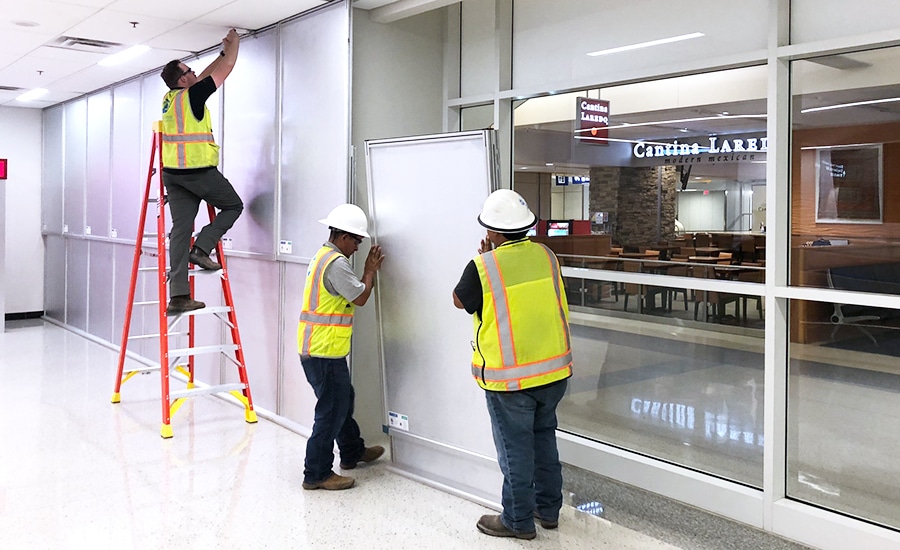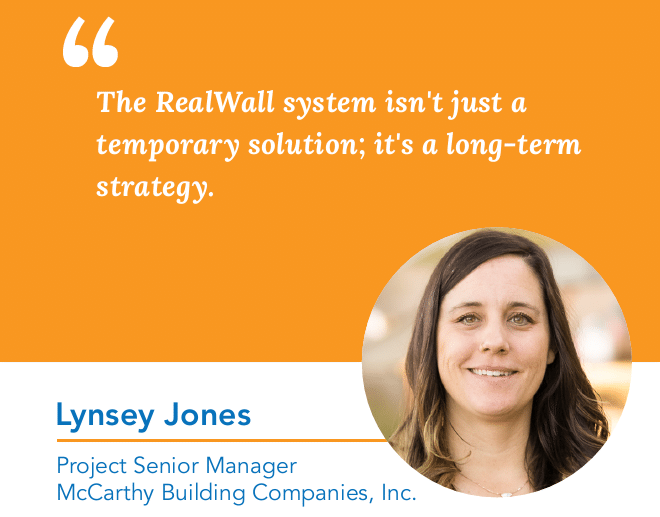
Construction trends are evolving fast. With tighter budgets, shorter timelines, and fewer skilled workers, the industry is under pressure to build smarter. Contractors are turning to innovative temporary wall systems to improve jobsite efficiency, reduce waste, and stay competitive in a changing market.
Once treated as disposable or last-minute additions, temporary walls are now part of a broader shift toward smarter, faster, and safer construction practices. This post explores how reusable temporary construction walls—like STARC’s RealWall™—align with today’s biggest construction trends, from modular thinking and speed of install to compliance and waste reduction.
How Today’s Construction Trends Are Redefining Jobsite Efficiency
Today’s jobsite success isn’t measured just by what gets built, but how quickly, safely, and adaptably it happens. Across commercial construction, teams face a high-stakes balancing act: meet aggressive schedules, manage labor shortages, and satisfy stricter safety and compliance standards.
Here are three major shifts shaping how modern contractors are rethinking efficiency—and how temporary wall systems fit into that future.
1. Shrinking Timelines and Labor Constraints
According to Dodge Construction Network’s 2024 SmartMarket Brief, over 70% of contractors expect schedule acceleration to remain a top challenge through 2025—a reality reinforced by more recent findings.
As Not by Design: The True Cost of Poor Collaboration (Sept. 2024) found, 62% of small and midsize construction firms reported experiencing project delays in the past year directly linked to poor collaboration and miscommunication.
This double pressure—compressed timelines combined with avoidable inefficiencies—means contractors must choose tools and methods that save hours, not just minutes. Whether renovating in phases or working in sensitive environments like healthcare facilities and data centers, rapid setup has shifted from “nice to have” to non-negotiable.
Learn the true cost of temporary drywall. Download our free eBook.
2. Safety and Compliance at the Forefront
From ICRA 2.0™ and ASTM E84/E119 to NFPA 241 and evolving local codes, safety standards extend far beyond PPE and signage. Temporary wall systems must deliver lasting performance—whether to prevent dust infiltration in an occupied hospital wing or to meet fire-resistance requirements during tenant improvements.
Reusable temporary wall systems like STARC’s are increasingly viewed as integral to maintaining compliance without slowing project schedules.
See our guide: Protecting Your Reputation During Renovations
3. Modular Thinking Is Reshaping the Jobsite
According to research from the McKinsey Global Institute, industrialized construction methods, such as modular components, off-site fabrication, and digital coordination, can deliver productivity gains of up to 60% compared to traditional approaches.
More recent analysis referenced by the World Economic Forum adds that volumetric modular construction can shorten project timelines by up to 50% and reduce costs by up to 20%, further reinforcing its value in an industry facing labor constraints and tighter schedules.
Temporary wall systems that follow this same logic—engineered, tool-free, and standardized—fit directly into this shift, offering consistent results regardless of crew size, location, or project complexity.
Temporary Construction Walls: From Afterthought to Efficiency Driver
For years, temporary walls were treated as a one-size-fits-all solution—usually built from on-site materials, constructed hastily, and torn down just as fast. They were functional, but far from efficient.
Today, that thinking is changing. As jobsites become more complex and fast-moving, temporary wall systems have evolved into a critical lever for project speed, cleanliness, and compliance. And with that shift, the expectations for performance have risen dramatically.
Why Temporary Drywall Isn’t Cutting It Anymore
Stick-built temporary drywall—framed, finished, and demolished after each phase—remains common on many jobsites. However, more contractors are questioning its viability as priorities shift toward speed, cleanliness, and sustainability:
- Slow to install – requires multiple trades and finishing
- Messy and disruptive – dust and noise in occupied spaces
- Wasteful – most materials go to landfill after one use
- Inflexible – reconfigurations require a full rebuild
See the comparison: Rejecting Drywall’s Hidden Costs.
The Case for High-Performance Temporary Walls
Reusable temporary construction walls from STARC deliver measurable gains across the areas that matter most.
- Speed: Install up to 100 linear feet per hour—no framing or finishing required
- Cleanliness: Gasket-sealed panels minimize dust migration and eliminate post-install cleanup
- Professionalism: Clean, real-wall appearance suitable for public-facing areas
- Adaptability: Panels reconfigure in minutes, not days
They don’t just contain dust, debris, and noise—they’re productivity enablers that help crews focus on the core scope of work, not the surrounding logistics.
Setup Time = Project Time
Time saved on wall installation is time earned elsewhere. Whether accelerating turnover in an airport terminal or maintaining compliance in a live healthcare environment, faster setup translates into:
- Shorter schedules
- Lower labor costs
- Improved margin protection
In environments where every hour of downtime carries a cost—like airport terminals, live healthcare environments, and 24/7 data centers—faster setup translates into a competitive edge.
Product Spotlight: RealWall
RealWall™ is engineered for environments where aesthetics and performance matter most:
- STC 24 acoustic rating – helps reduce disruption
- ICRA Class IV/V compliance – infection control ready
- Gloss-white aluminum finish – blends with modern interiors
- Installs much faster and easier than drywall
As jobsite demands evolve, STARC’s temporary wall systems are engineered to help you stay ahead—without slowing down or cutting corners.

Wall System Reusability: The Long Game for ROI
Instead of budgeting for single-use drywall in every phase or project, leveraging reusable temporary construction walls from STARC enables you to:
- Reduce material costs
- Cut labor hours
- Eliminate tons of landfill waste
At the end of their lifecycle, STARC walls are up to 95% recyclable by weight.
See our Full-Circle Commitment to Sustainability—Download Infographic
Construction Trends That Favor the Flexible
The most forward-thinking firms are rethinking how the jobsite operates—not just the tools they use.
Sustainability as a Standard
Construction and demolition debris in the U.S. totaled over 600 million tons in 2018—more than twice the volume of municipal solid waste generated that year, according to the U.S. Environmental Protection Agency. About 145 million tons of that material went to landfills. Drywall, discarded after a single use, is a major contributor.
STARC’s reusable walls are an ESG-friendly solution that can contribute toward LEED goals—through waste reduction, material reuse, and improved indoor environmental quality—without compromising performance.
Phased and Agile Construction
Renovations don’t always follow a linear path. With STARC’s modular, field-adjustable temporary wall systems, you can adapt without starting over.
Conclusion
As the construction industry evolves, efficiency is now a competitive advantage. Containing dust and debris, once an afterthought, is central to delivering faster, cleaner, and safer jobs.
STARC’s reusable temporary wall systems help you stay ahead, meet strict safety codes, and eliminate the waste and delays of traditional methods—while supporting the way your team actually builds.
Stop wasting time and materials doing things the old way. Discover how reusable construction walls can make your next project faster, cleaner, and more profitable.
Compare Products or Request a Quote to bring industry-leading temporary walls to your jobsite.
